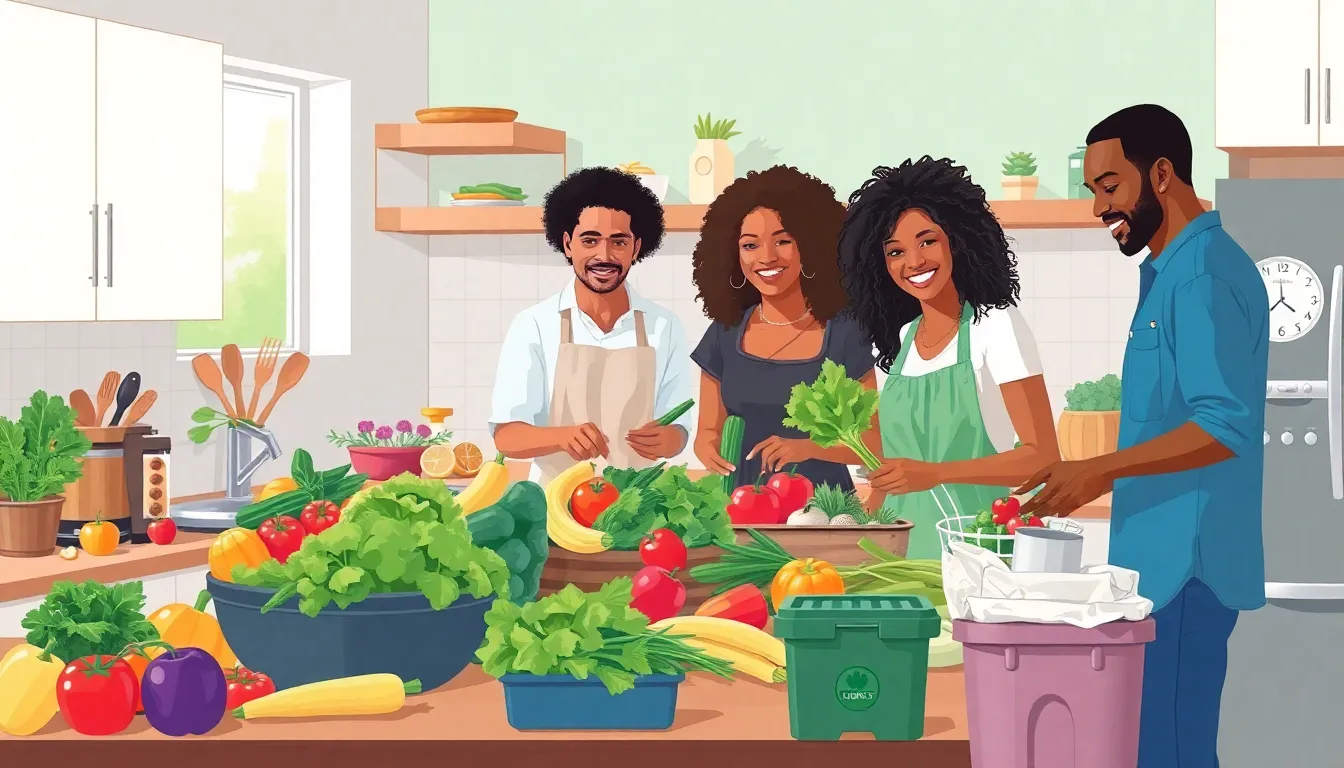In a world where trash cans seem to overflow faster than a toddler’s tantrum, zero waste recipes are like the superhero we didn’t know we needed. These culinary creations not only rescue food scraps from the landfill but also transform them into delicious meals that’ll make taste buds dance. Who knew saving the planet could be this tasty?
Zero Waste Recipes
Zero waste recipes focus on minimizing food waste by creatively using all parts of ingredients. These recipes transform food scraps into delicious meals and snacks, showcasing resourcefulness in cooking. Embracing zero waste cooking leads to reduced environmental impact and promotes sustainability.
Common ingredients often wasted include vegetable peels, herb stems, and stale bread. Utilizing these parts not only improves culinary creativity but also saves money. For instance, vegetable scraps can become flavorful broths, while stale bread finds new life as croutons or breadcrumbs.
Zero waste recipes encourage using leftovers in innovative ways. Turning last night’s dinner into a hearty soup or stir-fry exemplifies this principle. Creative meal planning and portion control also play significant roles in achieving zero waste.
Many people find joy in experimenting with their cooking by using what they already have. Ingredients that may seem unusable can add unique flavors and textures to dishes. For instance, citrus peels can flavor marinades, while overripe fruits make excellent smoothies or baked goods.
Ultimately, zero waste recipes promote a circular economy within home kitchens. They inspire individuals to think critically about their food choices and possible waste, leading to a more sustainable lifestyle. Zero waste cooking offers a practical, enjoyable approach to contributing positively to the environment.
Benefits of Zero Waste Recipes

Zero waste recipes provide numerous advantages, merging culinary innovation with sustainability. These meals not only reduce food waste but also promote a healthier environment.
Environmental Impact
Zero waste recipes significantly reduce food waste, lowering methane emissions from landfills. Utilizing all parts of ingredients minimizes the need for new resource extraction and transportation. Composting food scraps further enriches soil while cutting down on waste. Embracing this cooking style fosters a circular economy, where nothing goes to waste and resources get reused. Each meal creatively repurposes ingredients, directly supporting sustainability efforts. Choosing zero waste methods contributes to a less pollutant environment, encouraging eco-conscious cooking habits.
Cost Savings
Zero waste recipes lead to substantial cost savings in the kitchen. By using food scraps and excess ingredients, individuals stretch their grocery budgets. Transforming vegetable peels into broths or stale bread into croutons maximizes every purchase. Builders of these recipes often find they buy less while enjoying more diverse meals. Planning meals around what’s available reduces impulse purchases, enhancing financial efficiency. Overall, zero waste initiatives not only save money but also diminish unnecessary spending on convenience items, promoting more mindful consumption.
How to Get Started with Zero Waste Recipes
Getting started with zero waste recipes transforms how one approaches cooking and food consumption. Embracing this method promotes sustainability and creativity in the kitchen.
Essential Ingredients
Using commonly discarded food items forms the basis of zero waste cooking. Vegetable scraps, such as peels and stems, add flavor to stocks and soups. Citrus peels provide zest in dressings and baked goods, enhancing overall taste. Stale bread functions as a key component in croutons or breadcrumbs, minimizing waste. Leftover herbs can be blended into pestos or seasoning mixes, ensuring no part goes unused. Choose seasonal produce, as it typically comes with fewer food miles and supports local economies. Keeping these ingredients on hand helps maintain a zero waste kitchen.
Kitchen Tools to Use
Certain kitchen tools prove invaluable for zero waste recipes. A sturdy cutting board accommodates diverse food preparation tasks. Investing in a high-quality knife aids in efficiently processing fruits and vegetables. Containers for storing leftovers and scraps promote organization and easy access. A blender or food processor enables quick transformations for surplus ingredients into sauces, dips, or smoothies. Reusable storage bags or beeswax wraps ensure food remains fresh while reducing reliance on plastic. Incorporating these tools enhances the zero waste cooking experience, making it simple and enjoyable.
Easy Zero Waste Recipes to Try
Creating zero waste meals is simple and fun. Below are some easy recipes to incorporate into daily meals.
Breakfast Ideas
Use stale bread to make delicious French toast. Soak slices in a mixture of eggs and milk, then cook on a skillet until golden brown. Another option involves banana peels, which can be blended into smoothies for added fiber. Whisked together with leftover smoothie ingredients, they make for an innovative breakfast drink. For a twist on oatmeal, try using leftover citrus peels. Simmer them with oats and water, creating a zesty flavor profile.
Lunch and Dinner Options
Repurposing vegetable scraps into a hearty broth is a practical choice. Combine onion peels, carrot tops, and celery leaves in a pot, adding water and seasonings. Cook until flavors merge, then strain and enjoy. Stale bread can also be transformed into croutons. Toss chunks with olive oil and dried herbs, bake until crisp, and add to salads or soups. Herb stems, often discarded, can provide a flavor boost when added to sauces or stews, enhancing dishes with minimal waste.
Tips for Reducing Food Waste in Your Kitchen
Use flexible meal planning to minimize food waste. This strategy involves creating recipes around available ingredients. Keeping track of expiration dates on food items helps prioritize usage, preventing spoilage.
Incorporate a “first in, first out” system in the pantry. Placing newer items behind older stock ensures that nothing goes unnoticed, which reduces waste.
Utilize storage methods that extend the life of ingredients. For example, tightly sealing bags of greens or using airtight containers for grains prolongs freshness. Freezing excess food is an effective way to preserve ingredients that might otherwise spoil.
Exercise creativity when it comes to leftovers. Transforming last night’s dinner into a new dish can make meals exciting and reduce waste.
Explore preserving techniques such as pickling or fermenting. These methods enhance flavor while extending the shelf life of surplus produce.
Engage the family in discussions about meal portions. Learning to serve appropriate amounts not only reduces leftovers but promotes mindful eating.
Implement a composting system for unavoidable scraps. Composting vegetable peels and cores enriches soil and contributes to a healthier ecosystem.
Seek out local sources for produce. Supporting farmers markets often results in fresher ingredients, which translates to less waste due to spoilage.
Experiment with zero waste recipes as part of daily cooking routines. Innovative dishes encourage resourcefulness and demonstrate that every part of the food is useful. By following these tips, anyone can take meaningful steps towards a more sustainable kitchen.
Conclusion
Embracing zero waste recipes not only transforms the way meals are prepared but also cultivates a deeper connection to food and the environment. By creatively utilizing food scraps and minimizing waste, individuals can enjoy delicious meals while contributing to a more sustainable future.
The journey into zero waste cooking encourages resourcefulness and innovation in the kitchen. It fosters a sense of accomplishment as one learns to make the most out of every ingredient.
With practical tips and easy recipes at hand, anyone can embark on this rewarding culinary adventure. As more people adopt these practices, the collective impact on reducing food waste and promoting sustainability becomes increasingly significant.

